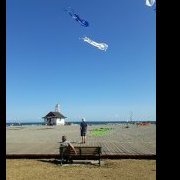Tones And Signs
-
Recently Browsing 0 members
- No registered users viewing this page.
-
Topics
-
-
Popular Contributors
-
-
Latest posts...
-
59
Accident India Orders Urgent Boeing Fuel Switch Checks After Deadly Crash
Glad you spent your time fruitfully, no need to be sorry 1. Did the software have a known bug? US aviation expert Mary Schiavo refers to a similar Boeing 787 incident involving All Nippon Airways in 2019, where both engines failed due to a software glitch — the aircraft's system falsely believed it was on the ground and cut fuel accordingly. The Japanese airline could fortunately be towed whilst Air India had no chance- no altitude or time to recover. 2. Poor cockpit design Even if one of the pilots operated the switch mid-take off, it may not have been deliberate. The stabilizer control switches — which the crew reported issues with earlier — are located next to the fuel cut-off switches. In the chaos of a stabilizer failure, a pilot could reach for one switch and hit the other. 3. Regulators were warned yet no inspections Less than a month before the crash, the UK Civil Aviation Authority issued a warning over fuel shutoff valve issues on Boeing aircraft, including the 787. The fuel control system had shown signs of potential failure across multiple models, however Air India didn't check the locking mechanism of the AI171’s fuel switch because a 2018 FAA advisory about the component was only that -advisory, not compulsory. -
6
Trump Fires Maurene Comey, Epstein's Prosecutor
You mean copy & pasted by others -
6
Trump Fires Maurene Comey, Epstein's Prosecutor
, according to two people familiar with the matter who were granted anonymity because they were not authorized to speak publicly. so cannot be verified. you derangement sufferers always post 'bombshell' articles that are always based on anonymous sources.... the same stories are run by all the msm, then you all claim things are 'widely reported', when in fact its called circular reporting. -
4
THAILAND LIVE Thailand Live Friday 18 July 2025
Swede, Aussie Found Dead Hours Apart in Same Pattaya Condo Picture courtesy of Amarin TV In a startling incident that has left Pattaya City reeling, two foreign men were discovered dead in the same condominium building within hours of each other. Thai police have launched an intensive investigation to resolve the confusion surrounding these deaths. Full story: https://aseannow.com/topic/1367047-swede-aussie-found-dead-hours-apart-in-same-pattaya-condo/ -
195
Epstein Coverup Continues
MAGA cult is posting all the time about how Trump will sail through the mid-term elections with another majority for the Republicans. My prediction is that Trump will not be around by that time. -
0
Report Swede, Aussie Found Dead Hours Apart in Same Pattaya Condo
Picture courtesy of Amarin TV In a startling incident that has left Pattaya City reeling, two foreign men were discovered dead in the same condominium building within hours of each other. Thai police have launched an intensive investigation to resolve the confusion surrounding these deaths. The tragedy unfolded when authorities first responded to a call at 2 p.m. regarding the death of a 38-year-old Swedish man, Mr. Mika Huotari, found in a fifth-floor unit. Mr. Huotari was discovered naked in an overflowing Jacuzzi, with a noticeable laceration on his forehead and right eyebrow. Blood seeped into the water beneath him, but intriguingly, the room showed no evidence of a struggle. Just two hours later, police were summoned again to the same building. This time, they found a 54-year-old Australian, Mr. Michael Shane, dead on the seventh floor. He lay in a pool of blood with a broken glass near his elbow, surrounded by scattered medicine bottles, yet again with no signs of a violent struggle. The unsettling nature of these finds has cast a cloud of suspicion and concern over the condominium’s residents. Ms. Thanchan ok Prajit, the 27-year-old caretaker, became involved when a friend of Mr. Shane reached out due to a lack of contact for two days. Detecting a foul odour emanating from Mr. Shane's locked room, she swiftly took action by calling the police, setting off a grim sequence of discoveries. Police diligently photographed the scenes and collected evidence from both locations. The deceased were then transported to Pattakhun Hospital, with their relatives informed of the tragic occurrences. The investigation now hinges on piecing together the events leading to these sudden deaths, a task compounded by their proximity in location and timing. Authorities remain cautious, with no leads dismissed at this early stage. As the investigation deepens, forensic analysis will play a pivotal role in understanding whether these incidents were tragic coincidences or part of a more sinister plot. The police urge anyone with information that could aid their inquiry to come forward. The unsettling dual discoveries in such a close timeframe have stirred unease in the community. While no direct link between the deaths has been established, the eerie circumstances ensure that the inquiry remains a high priority for Pattaya’s law enforcement. The city awaits answers as investigators work tirelessly to uncover the truth. Adapted by ASEAN Now from Thai Newsroom 2025-07-18
-
-
Popular in The Pub





.thumb.jpg.3ee24d9400fb02605ea21bc13b1bf901.jpg)

.thumb.jpeg.d2d19a66404642fd9ff62d6262fd153e.jpeg)





Recommended Posts
Create an account or sign in to comment
You need to be a member in order to leave a comment
Create an account
Sign up for a new account in our community. It's easy!
Register a new accountSign in
Already have an account? Sign in here.
Sign In Now